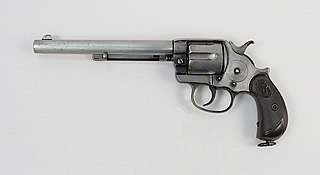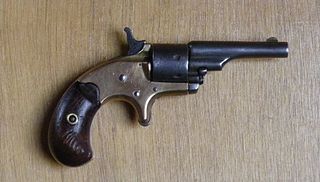
A revolver is a repeating handgun that has at least one barrel and uses a revolving cylinder containing multiple chambers for firing. Because most revolver models hold up to six cartridges, before needing to be reloaded, revolvers are commonly called six shooters.

A derringer is a small handgun that is neither a revolver, semi-automatic pistol, nor machine pistol. It is not to be confused with mini-revolvers or pocket pistols, although some later derringers were manufactured with the pepperbox configuration. The modern derringer is often multi barreled, and is generally the smallest usable handgun of any given caliber and barrel length due to the lack of a moving action, which takes up more space behind the barrel. It is frequently used by women because it is easily concealable in a purse or a stocking.

The Colt Single Action Army is a single-action revolver handgun. It was designed for the U.S. government service revolver trials of 1872 by Colt's Patent Firearms Manufacturing Company and was adopted as the standard-issued pistol of the U.S. Army from 1873 until 1892.

The .45 Colt (11.43×33mmR), is a rimmed, straight-walled, handgun cartridge dating to 1872. It was originally a black-powder revolver round developed for the Colt Single Action Army revolver. This cartridge was adopted by the U.S. Army in 1873 and served as an official US military handgun cartridge for 19 years, before being replaced by the .38 Long Colt in 1892.

The .32 S&W Long, also known as 7.65x23mm, is a straight-walled, centerfire, rimmed handgun cartridge, based on the earlier .32 S&W cartridge. It was introduced in 1896 for Smith & Wesson's first-model Hand Ejector revolver. Colt called it the .32 Colt New Police in revolvers it made chambered for the cartridge.
A. Uberti, Srl., is an Italian manufacturer of high quality replicas of 19th century American percussion revolvers, carbines, and rifles as well as cartridge revolvers, single-shot rifles, and lever-action rifles. These replicas are commonly used by historical re-enactors, participants in action shooting sports such as cowboy action shooting, working ranchers and target shooters who prefer traditional-style firearms. Thanks to their quality, Uberti replicas are also sought after by collectors and historical firearm enthusiasts.

William Mason was a patternmaker, engineer and inventor who worked for Remington Arms, Colt's Patent Fire Arms Manufacturing Company, and Winchester Repeating Arms Company in the 19th century.

Harrington & Richardson is an American brand of firearms and a subsidiary of JJE Capital Holdings. H&R ceased independent production February 27, 2015.

A snubnosed revolver is a small, medium, or large frame revolver with a short barrel, generally less than 4 inches in length. Smaller such revolvers are often made with "bobbed" or "shrouded" hammers and there are also "hammerless" models ; the point is to allow the gun to be drawn with little risk of it snagging on clothing. Since the external movement of the mechanism is minimal or nil, shrouded and hammerless models may be fired from within clothing. The design of these revolvers compromises range and accuracy at a distance in favor of maneuverability and ease of carry and concealment.

The Remington-Beals Model Revolvers along with subsequent models and variations were percussion revolvers manufactured by Eliphalet Remington & Sons in .31 (Pocket) .36 (Navy) or .44 (Army) caliber, used during the American Civil War, and was the beginning of a successful line of medium and large frame pistols. They are commonly, though inaccurately, referred to as the Model 1858 due to the patent markings on its New Model barrels, "PATENTED SEPT. 14, 1858/E. REMINGTON & SONS, ILION, NEW YORK, U.S.A./NEW MODEL."; although wide scale production did not start until 1861.

An antique firearm is a term used to describe a firearm that was designed and manufactured prior to the beginning of the 20th century. Although the exact definition of what constitutes an "antique firearm" varies between countries, the advent of smokeless powder or the start of the Boer War are often used as cut-off dates. Antique firearms are usually collected because of their historical interest and/or their monetary value.

A handgun is a firearm designed to be usable with only one hand. It is distinguished from a long gun which needs to be held by both hands and braced against the shoulder. Handguns have shorter effective ranges compared to long guns, and are much harder to shoot accurately. While most early handguns are single-shot pistols, the two most common types of handguns used in modern times are revolvers and semi-automatic pistols, although other handguns such as derringers and machine pistols also see infrequent usage.

The Ruger Old Army is a black-powder percussion revolver introduced in 1972 by the Sturm, Ruger company and manufactured through 2008. Models were made with a 7.5" and a 5.5 inch barrel.

The Colt M1878 is a double-action revolver that was manufactured by Colt's Manufacturing Company from 1878 until 1907. It is often referred to as the "Frontier" or the "Double Action Army" revolver. A total of 51,210 Model 1878 revolvers were manufactured, including 4,600 for the US Ordnance Department. These are known as the "Philippine" or "Alaskan" models.

Remington Model 1875 Single Action Army was a revolver by E. Remington & Sons. It was based upon the successful New Model Army with both revolvers having the same size, appearance, and the removable cylinder. The new 1875 Remington differed mainly from the older 1858 percussion model by having a bored through cylinder chambered for metallic cartridges. Thus, in 1875, Remington entered the cartridge revolver market with this big-frame, army style revolver, intended to compete with the Colt Peacemaker. Ordinary citizens and Old West lawmen alike recognized the sturdy quality of the new Remington revolvers. This design was followed by the Model 1888 and the Model 1890.

The Colt New Line was a single action pocket revolver introduced by the Colt's Patent Fire Arms Manufacturing Company in 1873.

The Colt House Revolver was one of the first metallic cartridge rear-loading revolvers to be produced by the Colt's Patent Fire Arms Manufacturing Company, in 1871. The same year, Colt's also patented the Colt Open Top, another metallic cartridge rear-loader, but in fact the Open Top production didn't start until 1872, although a pocket version of the Open Top, a completely different design, went on sales as of 1871, the Colt Open Top Pocket Model Revolver.

The Remington Model 1890 New Model Army was a revolver by Remington Arms. It was based on the successful Remington Model 1875 and the lesser known Model 1888 with both revolvers having the same size, appearance, and the removable cylinder. The 1890 Remington single-actions kept the solid frame and similar styling of the 1875 model, but lacking the large web under the ejector rod housing and equipped with checkered rubber grips. Like the 1875 model, the 1890 was suitably made for metallic cartridges, but only issued in .44-40 caliber.

The Colt Open Top Pocket Model Revolver was a single action pocket revolver introduced by the Colt's Patent Fire Arms Manufacturing Company in 1871. Introduced a year before the Colt Open Top and two years before the Colt Peacemaker and the Colt New Line, the Colt Open Top Pocket Model Revolver was, alongside the Colt House Revolver, one of the two first metallic cartridge rear-loading revolvers manufactured by Colt's. It also was one of the first pocket metallic cartridge revolvers made by the company.

The Smith & Wesson Model No. 2 Army a.k.a. Model No. 2 Old Model Smith & Wesson Revolver was Smith & Wesson's first .32 caliber revolver, intended to combine the small size and convenience of the Smith & Wesson Model 1 .22 rimfire with a larger caliber. Chambered in the .32 rimfire long caliber, its cylinder held 6 shots. It was manufactured 1861 - 1874, with a total production of 77,020.




















